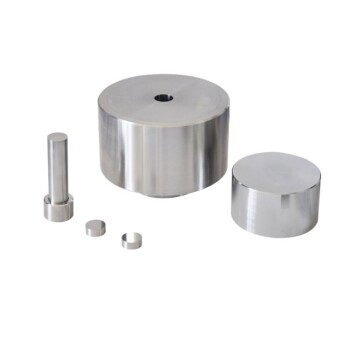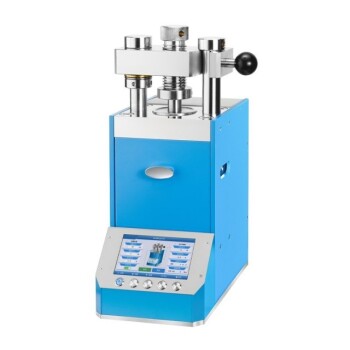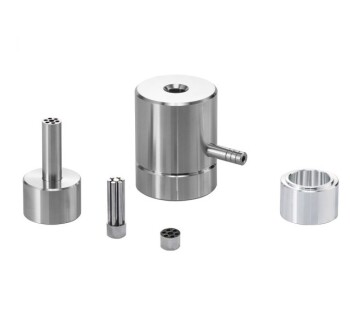In laboratory presses, platen size is a fundamental specification that dictates the operational capacity and efficiency of the equipment. These heated plates vary from small, square dimensions of just a few inches to large rectangular surfaces for industrial-scale work. The size you choose directly impacts the types of samples you can process, the pressure you can achieve, and the overall efficiency of your workflow.
Choosing the right platen size is a critical balancing act. While a larger platen offers versatility for bigger samples, it demands significantly more force to achieve the same pressure (PSI) and can negatively impact heating uniformity and cycle times.
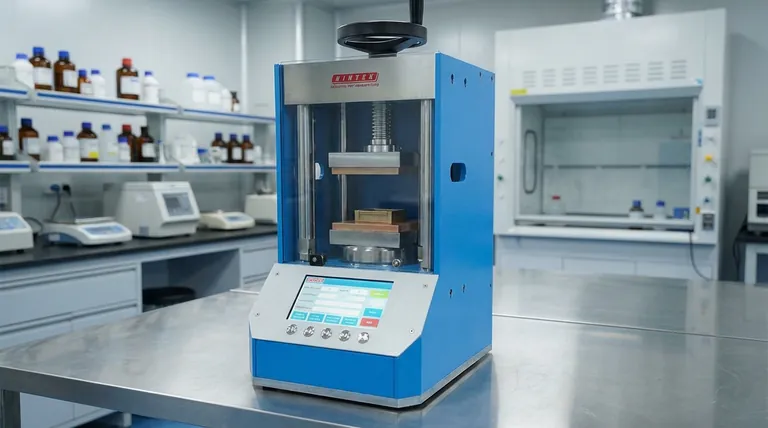
The Core Function of Platen Size
At the most basic level, the platen must be large enough to accommodate your sample or mold. However, the implications of this dimension go much deeper, affecting the physics of the entire pressing operation.
Common Size Categories
Most laboratory presses fall into a few standard size ranges. A smaller press might feature 6" x 6" or 9" x 9" platens, which are ideal for small-scale material testing, quality control pucks, or R&D where sample material is limited.
Larger benchtop or pilot-scale presses often use 12" x 12" or 15" x 15" platens. These provide the flexibility to use larger molds, test bigger components, or even process multiple smaller samples simultaneously.
The Critical Link Between Size and Pressure
This is the most important concept to understand. The total force of a press (measured in tons) is not the same as the pressure applied to your sample (measured in pounds per square inch, or PSI).
Pressure is calculated as Force ÷ Area. This means that for a press with a fixed tonnage, a larger platen will result in lower achievable pressure because the force is spread over a greater area.
Think of it like the difference between a snowshoe and a stiletto heel on snow. A person's weight (force) is constant, but the stiletto (small area) sinks deeply because it generates immense pressure, while the snowshoe (large area) stays on top. A 25-ton press with small platens can generate much higher PSI than a 50-ton press with massive platens.
Understanding the Trade-offs
Selecting a platen size is not about getting the biggest one you can afford. The goal is to choose the most appropriate size for your primary application, as choosing incorrectly introduces significant inefficiencies.
The "Too Big" Problem
Using a platen that is vastly larger than your sample is inefficient. You are heating excess steel, which wastes energy and increases the time it takes to reach your target temperature.
Furthermore, it may be difficult or impossible to achieve the required PSI for your material if the platen area is too large for the press's tonnage capacity.
The "Too Small" Problem
This is a more obvious limitation. Your mold or sample simply will not fit, rendering the press useless for that application.
Even if the sample barely fits, parts of it may be too close to the edge of the platen. This can lead to uneven heating and inconsistent results, as the edges of platens can sometimes be slightly cooler than the center.
Impact on Heating and Cooling
Larger platens have a greater thermal mass. This means they take longer to heat up and longer to cool down.
If your process requires rapid heating and cooling cycles, a smaller, more nimble platen system will always outperform a larger one. Slower cycles reduce laboratory throughput and can impact material properties.
Making the Right Choice for Your Application
Your decision should be driven by a clear understanding of your materials and process goals.
- If your primary focus is R&D with small, varied samples: Opt for a smaller standard platen (e.g., 6" x 6" to 9" x 9") to maximize pressure control and minimize material waste.
- If your primary focus is high-pressure applications: Prioritize a smaller platen, as it will require less total press tonnage to achieve the high PSI your material demands.
- If your primary focus is pilot production or testing larger components: Select a platen size that comfortably accommodates your largest anticipated mold with a small border (e.g., 12" x 12" or larger).
- If your primary focus is running multiple samples at once: Ensure the platen area is large enough to hold all your molds without them touching, and verify the press can deliver adequate force for the total surface area being pressed.
Ultimately, matching the platen size to your specific material and process requirements is the key to achieving repeatable and reliable results.
Summary Table:
| Platen Size | Best For | Key Considerations |
|---|---|---|
| 6" x 6" to 9" x 9" | Small-scale R&D, quality control | Maximizes pressure, minimizes material waste |
| 12" x 12" to 15" x 15" | Pilot production, larger components | Balances size and force for flexibility |
| Larger sizes | Industrial-scale work | Requires high tonnage, may impact heating uniformity |
Struggling to choose the right platen size for your lab press? KINTEK specializes in lab press machines, including automatic lab presses, isostatic presses, and heated lab presses, designed to meet the diverse needs of laboratories. Our experts can help you select the perfect platen size to enhance efficiency, achieve precise pressure control, and improve heating uniformity for your specific applications. Contact us today to discuss your requirements and boost your lab's performance!
Visual Guide
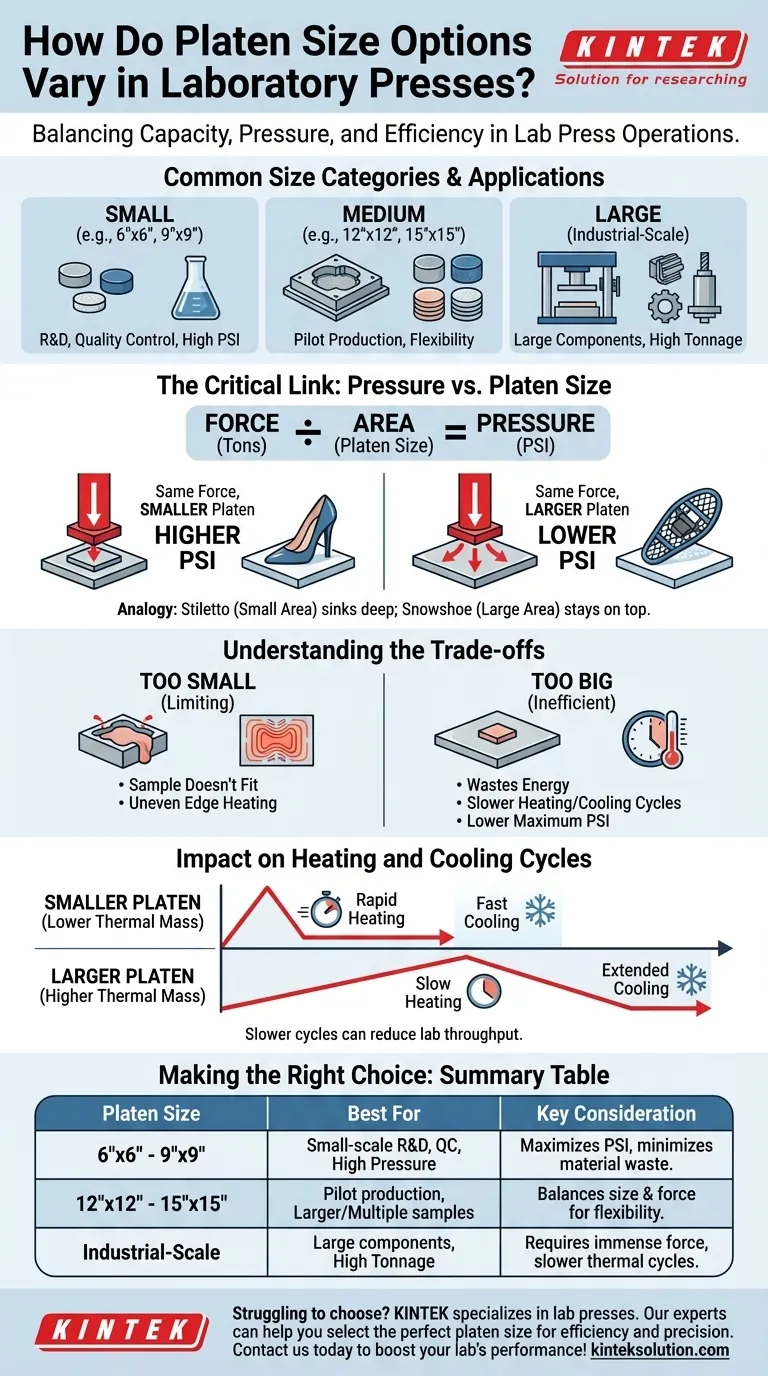
Related Products
- Automatic Laboratory Hydraulic Press Lab Pellet Press Machine
- Laboratory Hydraulic Press 2T Lab Pellet Press for KBR FTIR
- Laboratory Hydraulic Press Lab Pellet Press Button Battery Press
- Manual Laboratory Hydraulic Press Lab Pellet Press
- Automatic Laboratory Hydraulic Press for XRF and KBR Pellet Pressing
People Also Ask
- How do hydraulic press machines ensure precision and consistency in pressure application? Achieve Reliable Force Control for Your Lab
- How do hydraulic pellet presses contribute to material testing and research? Unlock Precision in Sample Prep and Simulation
- What is the purpose of creating pellets for XRF spectroscopy using a hydraulic press? Ensure Accurate and Repeatable Elemental Analysis
- What are the advantages of using a hydraulic press for pellet production? Achieve Consistent, High-Quality Samples
- How does a hydraulic press aid in XRF spectroscopy? Achieve Accurate Elemental Analysis with Reliable Sample Prep









